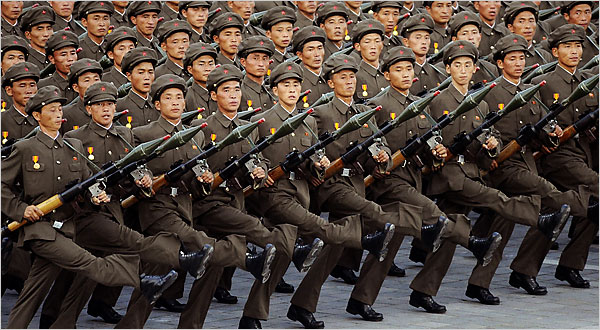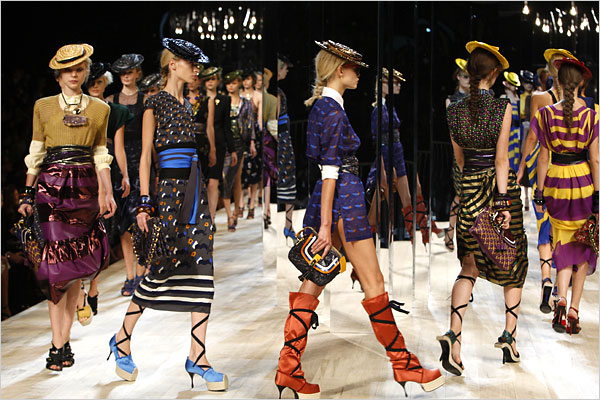If it seems too soon to really be in the 21st century, just take a look backwards.
This photograph of North Korean troops on parade appeared on the front page of the New York Times earlier this week, but it’s really an example of time travel. North Korea is one of the last countries in the world that is trapped in the past century. A rigidly totalitarian state, command economy, and extreme isolation combine to keep the people miserable. For once, a stock photograph seems the appropriate documentary report.
The photo is nothing if not conventional. You can look through it to generations of Soviet May Day parades and before that the German Wehrmacht goose-stepping through Europe. Indeed, this is the most typical image of the totalitarian state: militaristic, uniformed, regimented, everyone marching in lock-step formation. Machine-like regimentation concentrates power in the state while making individuals interchangeable and expendable.
Curiously, on the same day (Wednesday, September 10) the Times featured a very different story on the same front page. I don’t have the exact photo that was used in the paper edition, but this is a variant from the online slide show:
It’s Fashion Week in New York, and the show by Marc Jacobs was featured in part because he “used the early 20th century as the inspiration for his latest collection.” Compared to the photo of the North Korean soldiers, this scene would seem to be from another planet. But look again: Although each model is arrayed differently, they are marching in formation, the actual individuals are interchangeable parts in a production controlled completely by others, and the entire display has little bearing on what ordinary people actually do. The riot of color serves the same purpose as the drab uniforms of the soldiers: individuals are woven into a culture defined by a single orientation. In one we see the massed power and collective discipline of the state, in the other the richness of the market; both are ideological displays.
The two images have something else in common: complete gender segregation. This bifurcation carries another: politics in one place, society in another. The first image reduces modern politics to the nation-state’s monopoly on violence. The second image reduces modern society to conspicuous consumption in a private sphere having no visible politics at all. Thus, both photos reproduce one of the stock assumptions of modern political thought: that politics and society are essentially separate spheres, each having its own autonomy and each disrupted by any intrusion from the other realm.
In the 21st century this fiction is becoming increasingly dated. From suicide bombers to Blackwater mercenaries, creationists to environmentalists, free trade to slow food, third world modernization to global warming, it is clear that society and politics are complexly interwoven. Of course, there still is need for distinctions that protect both individual and common interests. (I want to maintain the relative autonomy of church and state, for example.) That said, this is a time for moving beyond the old binaries. They are so twentieth century. More to the point, such stock images and conventional assumptions get in the way of creating a better world.
Photographs by Kyodo News via Associated Press and Richard Temine/New York Times.


Good stuff. If you ever end up publishing any of this material in a format that would lend itself to classroom teaching then this post is an example of why it would be a great addition to sociology courses (in addition to others, obviously).